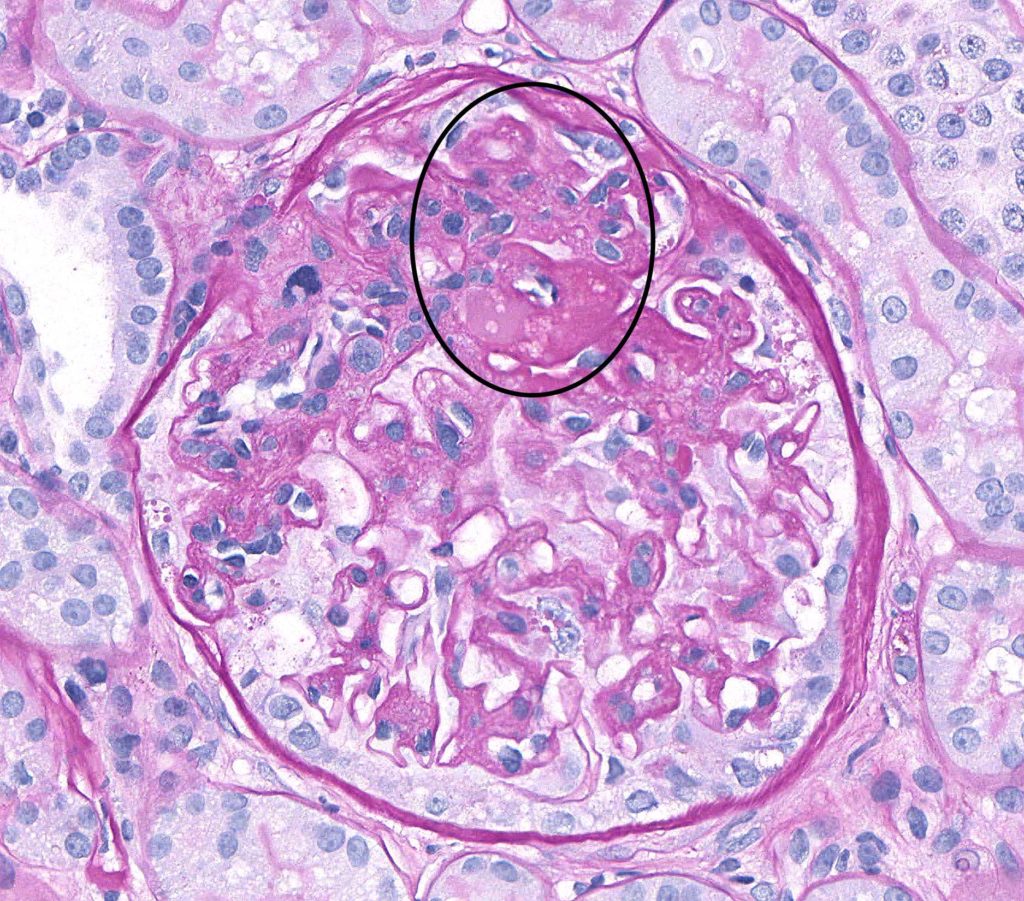What is focal segmental glomerulosclerosis (FSGS)?
Focal segmental glomerulosclerosis (FSGS) is one of the 7 types of chronic glomerulonephritis (GN). They are all ‘autoimmune diseases’ where the immune (defence) system attacks normal tissue in the kidney (including the glomerulus). Why and how they occur is unclear. FSGS affects both children and adults.
The phrase ‘sclerosis’ means scarring of the kidney. ‘Segmental’ means scarring only takes place in parts of each glomerulus (tiny filtering unit, or sieve); and ‘focal’ means only a limited number of glomeruli are damaged at first.
Focal segmental glomerulosclerosis is the commonest primary cause of nephrotic syndrome in adults, accounting for 40% of cases (and 20% in children). FSGS can be broadly classified into primary (no known cause) or secondary (with a range of causes, see below). The NZ rugby union star Jonah Lomu had FSGS.
What causes FSGS?
FSGS is not caused by a single disease. It has different types, and many causes:
- Primary FSGS. This type of FSGS means that the disease happened on its own without a known or obvious cause. It is presumed to be an autoimmune disease, i.e. caused by your own immune (defence) system attacking the small blood vessels and glomeruli within the kidney
- Secondary FSGS. This type is caused by another disease or a drug. Examples include: obesity, viruses such as HIV, heroin, diabetes, high blood pressure, sickle cell disease, lupus (SLE) and drugs (bisphosphonates, anabolic steroids, and interferon). FSGS can also be caused by another glomerular disease that you had before you got FSGS
- Familial FSGS. This is a rare form of FSGS caused by genetic changes. It is suspected when several members of a family show signs of FSGS.
Tip variant
There is a sub-type of the primary FSGS group called the ‘tip variant’. It is called this because the scarring occurs at the ‘tip’ of the glomerulus (tiny filter). The symptoms of FSGS in the tip variant often appear quite rapidly. There is a tendency to develop severe nephrotic syndrome, with a large amount of protein in the urine. This variant also seems to be the most responsive to treatment, with most of the patients who receive steroids undergoing a full or partial response.
Symptoms
The most common presentation of FSGS (in over 70% of patients) is nephrotic syndrome, which shows itself as ankle/leg/around the eyes oedema (swelling), fatigue, and appetite loss. High blood pressure is another common feature and can be severe, with diastolic blood pressure over 120 mmHg.
Chronic kidney disease (CKD) can develop (quire rapidly, i.e. months) in some patients. Some of these patients go to develop CKD5 (kidney failure), and need dialysis and/or a kidney transplant (but FSGS can sometimes come back in the new kidney).
Diagnosis
Diagnosis of FSGS is made through medical assessment by a kidney specialist (nephrologist), blood and urine test, and a kidney biopsy. High cholesterol levels are common as well.

Typical glomerulus in a kidney biopsy on light (normal) microscopy, in FSGS. The abnormal area is ringed
Treatment
Treatments (depending on the type and severity of FSGS) may include:
- Medicines such as ACE inhibitors (angiotensin converting enzyme inhibitors) and ARBs (angiotensin receptor blockers) and SGLT2is (sodium-glucose cotransporter 2 inhibitors) to control blood pressure and protein loss
- Steroids (e.g. prednisolone) to treat nephrotic syndrome and diuretics (water tablets) to reduce oedema
- Other immunosuppressants (drugs that dampen down the immune system) may be needed. These include calcineurin inhibitors (CNIs), mycophenolate and rituximab
- Cholesterol lowering drugs (e.g. ‘statins’) may be necessary
- Blood thinning drugs (anticoagulants) may be needed to prevent blood clots
- Removal of both kidneys. This is very rare, but sometimes needs to be done when the protein losses in nephrotic syndrome are very high
- Dialysis and/or kidney transplantation.
Summary
We have described what is focal segmental glomerulosclerosis (FSGS). We hope it has been helpful.
Other resources
This is a good review article (for health professionals): Sangameswaran et al, 2023
This article by Tullus, 2023 emphasises FSGS is not one disease. It has variants and underlying causes.
Andy Cole and his kidney transplant
Jonah Lomu and his nephrotic syndrome
What is chronic glomerulonephritis?
What is minimal change disease?
What is membranous nephropathy?
What is IgA nephropathy?
What is post-infectious glomerulonephritis?
What is mesangiocapillary glomerulonephritis?
What is rapidly progressive glomerulonephritis?
https://www.youtube.com/watch?v=qNuGqvDdVko
Last Reviewed on 25 May 2024
